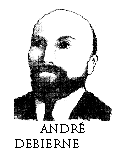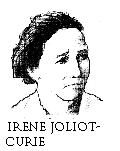The Discovery of Francium
Unless noted, the details of this tale are taken from Bertrand Goldschmidt’s "Atomic Rivals" (1990).
The July 1996 issue of Scientific American announced "Physicists have for the first time trapped atoms of francium, the rarest naturally occurring element." This is an extremely important achievement because francium’s simple structure might allow precise measurements of the weak nuclear interaction (responsible for radioactive decay). What follows is the TRUE and LITTLE KNOWN story of the discovery of francium.

In 1899, less than a year after beginning work with Pierre and Marie Curie, André Debierne discovered a new element: actinium. Ernest Rutherford wasn’t impressed: "I never felt that Debierne deserved much credit for actinium. As a matter of fact, if there had been a dozen [other radioactive] elements with actinium, he had not enough radioactive sense to find it out" (Badash 1969). Nevertheless, Marie was sufficiently pleased that she appointed Debierne as her chief assistant upon the death of her husband in 1906. When she died in 1934, Debierne assumed her role as Chief of the Curie Laboratory. It was a long time between promotions, but Debierne probably bore the Curies no ill will.
Debierne was short, stocky, and bald. And despite the level of sophistication attributed to those of us with beards, Debierne’s personality was not well suited to running a lab. He was an introvert who was gradually becoming more and more reclusive. Months of unopened mail piled up on his desk. Never married, and with few friends, his relationships might be said to last as long as he had someone in sight. He could finish a conversation with a person, shake hands, and turn out the lights as he exited the room—completely forgetting the individual left behind in the dark!

Had Debierne been better suited to the task, the lab’s internal rivalries would still have guaranteed plenty of conflict. Even Frederic Joliot-Curie, Marie’s son-in-law and participant in the laboratory’s greatest discovery, artificial radioactivity, succinctly described his relationship with the rest of the staff as "Me, I am hated." Irene, Frederic’s wife, and second in command to Debierne, was known for her no-nonsense attitude. She and Debierne didn’t get along. In fact, Debierne could be so provoked by Irene that his face and neck would go purple with rage. During one disagreement, when Irene objected to the appointment of Bertrand Goldschmidt to a position she believed belonged to someone else, Debierne retorted "Goldschmidt possesses a quality that all the others do not have—he did not work with your mother. Now get out of here!"
In 1938, Debierne and Irene, each unaware of what the other was doing, independently asked Marguerite Perey to prepare a sample of highly purified actinium. Irene intended to make an accurate measurement of actinium’s half-life, while Debierne was looking for an elusive new element "neoactinium." Trained in the chemistry of actinium by Marie Curie herself, Perey was perfect for the job. And it was while she was preparing the requested actinium, that Perey discovered the presence of a new short-lived element. Consulting independently with Debierne and Irene, Perey proceeded with the necessary characterizations. This went on for some time with Debierne and Irene each incorrectly assuming that they were Perey’s only coauthor in the discovery. Inevitably, they found out about the other’s involvement and the situation exploded. After a few months, a certain measure of calm returned and a compromise was reached: Perey would be the only official discoverer of the element which she named "francium." André Debierne and Irene Joliot-Curie each preferred no credit for themselves to some credit for the other.
References
- Badash, L. Rutherford and Boltwood - Letters on radioactivity. Yale University Press, New Haven; 1969.
- Goldschmidt, B. Atomic rivals. Rutgers University Press, New Brunswick; 1990.
